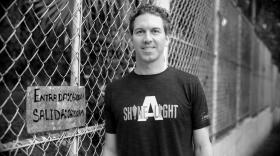The school district is facing another teacher shortage. How do we recruit fresh talent for the long term? Step 1: Change everything
According to school district officials, the 2014-2015 school year will have started last week with a shortage of about 400 teachers. Four hundred missing teachers? You get visions of unattended classrooms devolving into chaos — spitball fights, cinnamon challenges, Rock ’n’ Roll High School meets Lord of the Flies. Don’t fret. There will be someone at the head of every classroom — a long- or short-term sub, an aide working with an experienced teacher, maybe an existing staffer covering a class on his off-period. It’s not optional: The kids will show up; so must the adults, one way or another.
But the underlying problem requires a permanent fix. The teacher shortage extends far beyond Clark County and the August-May calendar. Interest in the profession is flagging, the market is shifting, and recruitment is undergoing a major transformation. Even as the Clark County School District’s Chief Human Resources Officer Staci Vesneske scrambles to fill vacancies, she and others are striving to repaint the big picture, getting college students interested in teaching again and keeping them in the profession — locally.
Where the teachers are
Over the last five years, the school district’s teacher and vacancy numbers have been particularly erratic. At the beginning of the 2008-2009 school year (the start of the great recession), the district had 830 vacancies and more than 18,000 total teachers. As the recession deepened, layoffs came in waves. By 2012-2013, there were only 348 vacancies at the beginning of the year and a little more than 17,000 total teachers.
Vesneske took her current position in 2011-2012 — and had to pivot from laying off hundreds to hiring more than 2,000 in 2013. As she surveyed the gaps, she noticed acute shortages in elementary and special ed. The latter was ongoing, but people looking for jobs in elementary school were usually abundant. She began looking for an explanation.
She learned there were fewer available candidates in markets such as California and Washington — rich recruitment markets for her predecessors. Why? As the economy picked up, districts in those states started hiring again, too. Also, class-size restrictions went back into effect. Classes got smaller, sponging up more teachers.
Meanwhile, college students have been turning away from education. The National Center for Education Statistics tracked more than 175,000 bachelor’s degrees in education conferred nationwide in 1970. By 2012, that number dropped to 105,785.
“It used to be that people would trade off salary for stability (in education),” Vesneske says, “but I think this time around, they just chose a new profession.”
Bringing education home
Kim Metcalf, dean of UNLV’s college of education, has also seen a decline in “program completers,” those who emerge from college ready to teach, through some combination of degree and licensure. In 2008-2009, UNLV had 423 such completers — a number that was already down from a historic high of around 600. But 2012-2013 saw the low point: 351.
Budget cuts in college education programs are also to blame, Metcalf says. With 40 percent of UNLV’s education college funding eliminated during the recession, it couldn’t have trained more students even if the interest had been there.
There are other reasons. The teaching profession has an image problem, seen more as a priestly calling that requires self-sacrifice than a serious career. “Many people going into teaching right now have the attitude of a missionary more than a professional,” Metcalf says. “They love kids, serving inner-city populations, and they’re willing to put up with negative perceptions.”
Plans to change the situation are under way. Vesneske has launched a new recruitment strategy, axing job fair attendance in favor of means preferred by millennials, such as online job boards and social media. A micro-website, vegasteaching.org, gives candidates a place to check out the school district, and Vesneske has launched several mentoring initiatives to help recruits with everything from preparing lesson plans to finding a hiking club.
Both the school district and UNLV’s education college are shifting resources to target students with degrees in other fields, luring them with programs for alternative routes to licensure. Vesneske and Metcalf would also like to establish a residency program, so student teachers could get paid while finishing their training in the classroom.
Hear more: Can parents get too involved in school? Hear a discussion on “ KNPR’s State of Nevada.”
But many more education majors are needed to turn the profession around. Metcalf recently committed UNLV’s education college to preparing 1,200 teachers a year, but to hit that number, he says, “we’d have to draw one of every 15 kids who graduates from CCSD. That’s one of every 15 graduates, not just the ones who plan to go to college.”
To accomplish that, he’ll have to make an education degree more appealing to students currently in elementary through high school. One old selling point is new again: job stability. Metcalf says 98 percent of his college’s graduate students get a job with CCSD.
But the circuit between primary and secondary education won’t be complete without job satisfaction. This is where principals come in.
New principal, new teacher
Grant Hanevold could serve as a model for The New Teacher Project, a movement to help school principals attract and retain talent. A 24-year CCSD veteran, Hanevold became principal at Sunrise Mountain High School in 2013, the year it was selected for turnaround. Of the previous 125 teachers, only 60 remained, leaving him 65 to hire. This school year, he retained all but 16, including some who retired and moved out of state.
How did he do it, besides by spending countless hours on the phone? “I was honest about the issues. I told them where the school was, where I wanted it to be. I had a 3-4 page big-picture plan, and I laid that out. I promised the teachers I would have their back, be there for ultimate support. I find ways to get them involved in a leadership capacity. I treat them like gold.” One effect of his approach: raising Sunrise’s graduation rate by 20 percent in one year.
Like Vesneske and Metcalf, Hanevold would appreciate a little help from the top. It’s hard, he acknowledges, for even the most motivated professional to drive 45 minutes across town every day to teach kids dealing with poverty and related issues.
“You have to either pay teachers in high-risk schools more to keep them — and the district’s not doing that yet — or give them classes with, say, 25 in a room instead of 30,” he suggests. “Most teachers aren’t in it for the money. They’re in it to make a difference. If you can’t reward them with money, you have to find other ways.”










